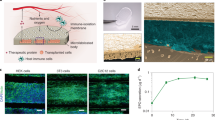Abstract
We have evaluated the feasibility and efficacy of intraperitoneal implants (neo-organs) for protein delivery in large animals. Skin biopsies were taken from four healthy dogs. Primary fibroblast cultures were transduced with a retroviral vector coding for the human β-glucuronidase. One to six lattices each containing 109 skin fibroblasts were implanted into the omentum of the donor animal. Laparotomies performed at regular intervals showed vascularized neo-organs without local inflammation. Human β-glucuronidase levels equivalent to 0.8 to 3.1% of the endogenous canine activity were detected for up to 340 days on liver biopsy samples. These results indicate that neo-organs can be considered for the long-term delivery of therapeutic proteins or enzymes in humans.
This is a preview of subscription content, access via your institution
Access options
Subscribe to this journal
Receive 12 print issues and online access
$209.00 per year
only $17.42 per issue
Buy this article
- Purchase on Springer Link
- Instant access to full article PDF
Prices may be subject to local taxes which are calculated during checkout
Similar content being viewed by others
References
Neufeld, E.F. & Muenzer, J. in The Metabolic Basis of Inherited Disease (eds Scriver, C.R., Beaudet, A.L., Sly, W.S. & Valle, D.) 1565–1587 (McGraw-Hill, 1989).
Hopwood, J.J. & Morris, C.P. The mucopoiysaccharidoses: diagnosis, molecular genetics and treatment. Molec. biol. Med. 7, 381–404 (1990).
Pfeffer, S.R. Targeting of proteins to the lysosome. Curr. Topics Microbiol. 1mmunoi. 170, 43–63 (1991).
Sando, G. & Neufeld, E.F. Recognition and receptor-mediated uptake of a lyso-somal enzyme, α-L-iduronidase, by cultured human fibroblasts. Cell 12, 619–627 (1977).
Kaplan, A., Achord, D.T. & Sly, W.S. Phosphohexosyl components of a lysosomal enzyme are recognized by pinocytosis receptors on human fibroblasts. Proc. natn. Acad. Sci. U.S.A. 74, 2026–2030 (1977).
Ullrich, R., Mersmann, G., Weber, E. & von Figure, K. Evidence for lysosomal recognition by human fibroblasts via a phosphorylated carbohydrate moiety. Biochem. J. 170, 643–650 (1978).
Krivit, W., Shapiro, E., Hoogerbrugge, P.M. & Moser, H.W. State of the art review, bone marrow transplantation treatment for storage diseases. Bone Marrow Transplant. 10, 87–97 (1992).
Vogler, C. et al. Enzyme replacement with recombinant β-glucuronidase in the newborn mucopolysaccharidosis type VII mouse. Pediat. Res. 34, 837–840 (1993).
Moullier, P., Bohl, D., Heard, J.M. & Danos, O. Correction of lysosomal storage in the liver and spleen of MPS VII mice by implantation of genetically modified skin fibroblasts. Nature Genet. 4, 154–159 (1993).
Moullier, P., Maréchal, V., Danos, O. & Heard, J.M. Continuous systemic secretion of a lysosomal enzyme by genetically-modified mouse skin fibroblasts. Transplantation 56, 427–432 (1993).
Naffakh, N. et al. Sustained delivery of erythtropoietin in mice by autologous inmplants of genetically-modified skin fibroblasts. Proc. natn. Acad. Sci. USA. in the press.
Dwarki, V.J. et al. Gene therapy for hemophilia A: Production of therapeutic levels of human factor VIII in vivo in mice. Proc. natn. Acad. Sci. U.S.A. 92, 1023–1027 (1995).
Wolfe, J.H. et al. Reversal of pathology in murine mucopolysaccharidosis type VII by somatic cell gene transfer. Nature 360, 749–753 (1992).
Bell, E. et al. The reconstitution of living skin. J. Invest. Dermatol. 81, 2s–10s (1983).
Achord, D.T., Brot, F.E., Bell, C.E. & Sly, W.S. Human β-glucuronidase: In vivo clearance and in vitro uptake by a glycoprotein recognition system on reticuloendothelial cells. Cell 15, 269–278 (1978).
Hayashi, M., Nakajima, Y. & Fishman, W.H. The cytologic demonstration of b-glucuronidase employing naphtol AS-BI glucuronide and hexazonium pararosanilin: A preliminary report. J. Histochem. Cytochem 12, 293–297 (1963).
Cardoso, J.E. et al. In situ retrovirus-mediated gene transfer into dog liver. Hum. Gene Ther. 4, 411–418 (1993).
Maréchal, V., Naffakh, N., Danos, O. & Heard, J.M. Disappearance of lysosomal storage in spleen and liver of mucopolysaccharidosis VII mice after transplantation of genetically-modified bone marrow cells. Blood 82, 1358–1365 (1993).
Danos, O. in Practical Molecular Virology: Viral Vectors for Gene Expression (eds. Collins, M.K.L.) 17–27 (Humana Press, Clifton, New Jersey, 1991).
Author information
Authors and Affiliations
Rights and permissions
About this article
Cite this article
Moullier, P., Bohl, D., Cardoso, J. et al. Long-term delivery of a lysosomal enzyme by genetically modified fibroblasts in dogs. Nat Med 1, 353–357 (1995). https://doi.org/10.1038/nm0495-353
Received:
Accepted:
Issue Date:
DOI: https://doi.org/10.1038/nm0495-353



